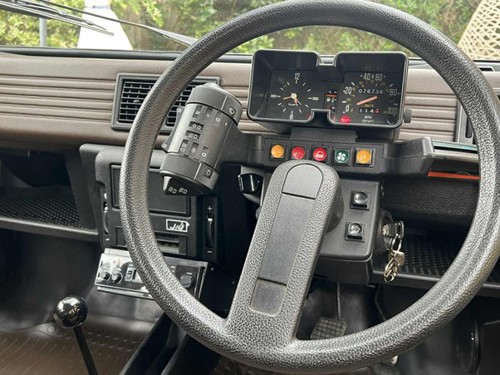A Vision in Mimosa Yellow – Andy Smith’s Citroen Visa Club
03 September 2025
When some people see Andy’s Visa, they do not mention its stunning Mimosa Yellow paint finish or its remarkable styling. Instead, they point out the ‘Coke Tins’ on the left side of the instrument display. Citroën preferred to refer to these devices as “PRN satellites” - P for “Pluie” (rain), R for “Route” (road), and N for “Nuit” (night). Andy recently acquired his very rare UK-market Club Series 1 due to memories of a Visa he owned in the late 1990s:
When I was about 18 or 19, I had a Visa GTi because it was incredibly expensive to insure a Peugeot 205 GTi. The Visa was about a quarter of the insurance costs and about a quarter of the price. Sadly, the running gear eventually failed, and at the age of 19, cars were seen as basically disposable, but I regret parting with that Visa. Over a quarter of a century later, I had the chance to buy one of the very few remaining Series 1s.

When Citroën launched the Visa in 1978, it attracted some complaints from marque die-hards as it was one of their first new models to reflect Peugeot’s influence. In the early 1970s, they collaborated with Fiat on an Ami replacement named Prototype Y, but the Peugeot takeover of 1974 led to its cancellation. Instead, Citroën embarked on Project VD (“Voiture Diminué”), based on the 104’s floorpan, under the guidance of Jean Giret.
When Citroën launched the Visa at the 1978 Paris Salon, some observers noted its choice of engines. The Spécial and the Club had the 2CV’s longitudinal-mounted air-cooled 652cc unit, while the flagship Super used the Peugeot 104 and Renault 14’s transverse ‘Douvrin’ 1,124cc unit. As for standard equipment, the Special was devoid of the Club’s hubcaps, reclining front seats, and clock, while the flagship Super had more luxurious upholstery, carpets, and a rear anti-roll bar.

UK imports began in 1979, and the sales copy stated that it would allow the owner to progress "smugly in winter when other cars dig their own graves with their rear wheel drives." In addition to the Mimosa Yellow of Andy’s splendid Visa, other shades included Nevada Beige, Myosotis Blue, Geranium Red, Nacre Grey, Reinette Green, and Nacre Grey.
According to Citroën GB, the Visa was “an example of what can be achieved by a design office which is determined to express the true personality of its marque while using the full resources of a large industrial group”. However, not everyone approved of the Visa’s looks. Autocar described it as "the work of a precocious wilful child curbed carefully by an intelligent, sensible, mother". Not to mention: “It still looks like its Citroën father – it couldn't help that with such a papa - but mère Peugeot shows up when you look at the children's legs and feet and indeed heart in the case of the elder brother".
Meanwhile, Autocar’s main rival Motor liked the Visa Club’s comfort, brakes, level of appointments, heating, and ventilation, but moaned about its finish, performance, and economy. Fortunately, Car was far more positive:
This is the time to come clean. We are among those who love the Citroën Visa's styling, who think its ride/handling compromise is just fine, and who can live with its engine’s meagre performance because of its character, its fuel consumption – and because across the ground the car is little slower than one with twice or even three times the engine capacity.
At £2,950, the Visa Club also had very few five-door rivals. The Honda Civic 1500 and the Renault 5 GTL were significantly more expensive at £3,380 and £3,551, respectively, although the former did have a much larger engine. The Citroën was also much cheaper than its £3,344 Peugeot 104GR stablemate, while five doors were not available on the Fiat 127, Ford Fiesta, or VW Polo.

March 1981 saw the launch of the facelifted Visa II with a new grille; the distinctive appearance of the early models was believed to be harming sales prospects. By 1984, there was a new fascia, which sadly had conventional stalks instead of satellite pods, and the AX succeeded the Visa in 1988. As for driving the Mimosa Yellow Club:
It feels so different from any modern car. The 0-60 time is not far off 30 seconds, and that is being optimistic. At anything above 60 mph, the engine goes from purring like a sewing machine to very loud. Braking requires more attention than acceleration, as it has no servo assistance. The seats are like big blocks of sponge, and the handling is halfway between a 2CV and a modern supermini in terms of body lean, which is all part of its charm.
Andy’s reasons for buying the Visa were memories of his GTi and his father’s old green Dyane 6. He remarks his Club feels completely different from his former Citroen - “down to the ‘pods’ as my GTi had stalks”. As for paternal Dyane - “I can still remember his spending a small fortune on a four-point child harness in the back”. It therefore seemed that with such a background that Andy would one day own a member of the Citroën ‘Flat Twin’ family.
And when Andy’s friend Jamie, a Visa collector, wanted to sell the Club, it naturally joined the Smith fleet. Today, “people seem to just crowd around the Visa, saying ‘my aunt used to have one’”. Not to mention Citroën’s claim that a Visa presented "A serious challenge to those who are ahead of the Joneses".
With thanks to Andy Smith for his time and permission to use the images in this blog.
